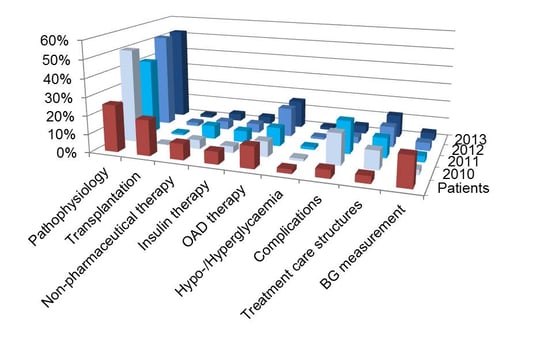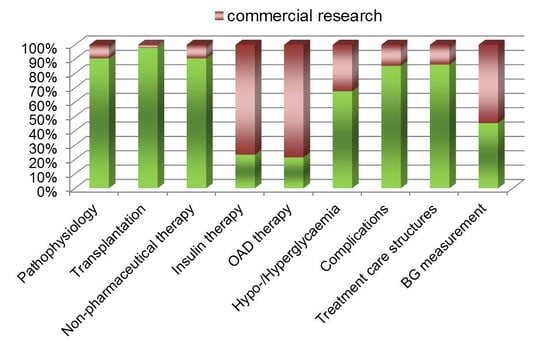What kind of research would people with diabetes like to see done and how does this compare to actual European diabetes research?
Up to now it has been unclear, which research topics and endpoints patients consider to be relevant for their daily treatment. An analysis of randomized phase II-IV trials showed that only 18% of diabetes related publications looked into patient relevant outcomes [1]. A survey in the US Midwest in 4796 people with diabetes and their relatives evaluated their preferences concerning the design of diabetes trials [2]. Patient-reported outcomes like e.g. death took precedence over surrogate markers (e.g. HbA1C) and studies with a practical design were favored over mechanistic or explanatory studies.
Longitudinal evaluation of EASD research areas 2010-2013 and comparison to a cross-sectional survey
As we at Profil benefit so much from the (repeated) participation of patients in our studies, we wanted to investigate the preferences and wishes of patients with diabetes for diabetes research topics. In order to include an, as far as possible, unselected sample of patients who were interested in diabetes research, the “stern”, one of the 3 most popular German weekly news magazines (www.stern.de) was selected for this study. 918 patients with diabetes and their relatives responded to a questionnaire posted in the printed and the online issue and stated their opinion on the most important topics in diabetes research. These opinions were then compared with the topics of abstracts submitted to the European Diabetes Meeting (EASD Annual Meetings) in the years 2010-2013. EASD clusters abstracts into 9 research categories. We allocated patients' preferences to the same categories and compared the number of abstracts with the numbers of expressed patients' preferences for each category [3, 4].
Results
About half of the presented research at EASD was dedicated to the category “Pathophysiology and prevention of diabetes and its complications” (covering pre-clinical research) – a number which remained stable over the investigated 4-year period. In contrast, only 25% of patients’ assessed this category as most important for diabetes research (Fig. 1).

- “Transplantation and cell therapy” reached high preference levels among patients (20% of assignments), but less than 2% of presentations at EASD covered this topic (Fig. 1).
- While there was an increase in presentations at EASD on “Blood glucose measurement, devices and artificial pancreas,” over the investigational period, it still only reached 4.3% in 2013, whereas patients had considered this category as the third most important one (16.4%; Fig. 1).
- EASD presentations related to “Diabetes complications in man” were over-represented in 2010 and 2011 when compared with patients' preferences, however, in 2012 and 2013 the number of presentations corresponded well with patients’ assignments (4.6%; Table, Fig. 1).
- The average part of EASD research related to the topic “Blood-glucose lowering therapy without insulin“ corresponded quite well with the part of research patients would like to see in this area (about 12%; increasing since 2010). Strikingly, the majority of presented studies in this category was commercially funded, so that a strong influence by the pharmaceutical industry cannot be excluded. The same applied for topic 4 “Insulin therapy” (6.9 vs 4.7%; Fig. 2).
- The proportion of commercial and non-commercial research varied substantially between the different research categories (Fig. 2). However, there was no difference in the (mis-)match between patients' and researchers' priorities between non-commercial and commercial research.

In summary, there is a strong discrepancy between patients' preferences in diabetes research and actually performed research as measured by EASD presentations in the last 4 years. This is most striking for basic, pre-clinical research that is strongly over-represented at EASD when compared with patients' desires, but also for “Transplantation and cell therapy” and “Blood glucose measurement, devices and artificial pancreas” that are of high importance to patients, but not very well presented at EASD.
Overall, a stronger involvement of people with diabetes in the selection of research topics is needed to obtain results that are relevant for patients' everyday treatment. At Profil we will intensify our commitment in patient-initiated research with several projects that will invite patients' feedback on both research topics and research results. We are confident that this feedback will be a huge help in further improving our research activities and obtaining results that are relevant for both our clients and people with diabetes.
References
[1] Gandhi GY, Murad MH, Fujiyoshi A et al. Patient-important outcomes in registered diabetes trials. JAMA 2008; 299: 2543-2549.
[2] Murad MH, Shah ND, Van Houten HK et al. Individuals with diabetes preferred that future trials use patient-important outcomes and provide pragmatic inferences. J Clin Epidemiol 2011; 64: 743-748.
[3] Arnolds S, Heckermann S, Heise T, Sawicki PT. Spectrum of diabetes research does not reflect patients’ scientific preferences: a longitudinal evaluation of diabetes research areas 2010-2013 vs. a cross-sectional survey in patients with diabetes. Exp Clin Endocrinol Diabetes 2015; 123: 299-302.
[4] Arnolds S, Heckermann S, Koch C, Heissmann N, Sawicki PT. How do patients’ preferences compare to the present spectrum of diabetes research? Exp Clin Endocrinol Diabetes 2013; 121: 60-63.




